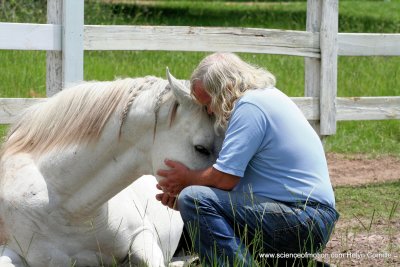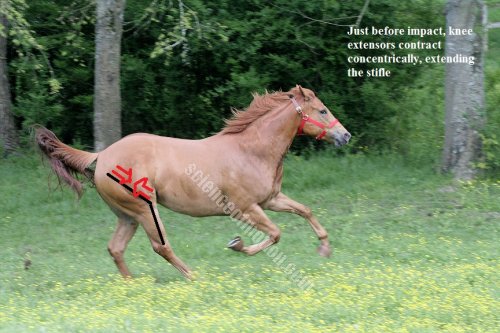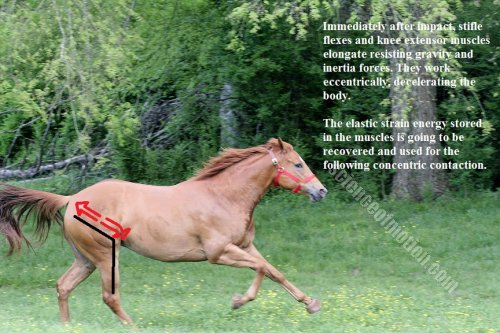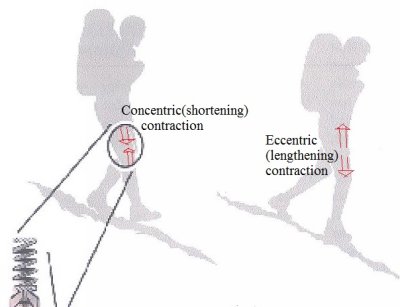Mechanoresponsiveness PT 9
Mechanoresponsiveness
Part 9
“If you listen to their breath, you will feel their heart.” (Dr. Jean Delsalle DVM)

Jean Luc & Chazot
Dr. Delsalle was half way retired sharing his time between the golf course and a few selected customers. The statement was about conditioning of the horses and health but the smile in his eyes was telling me that one day, as I will evolve beyond the winning frenzy, as I will become older and hopefully more intelligent, as I will appreciate the horses for who they are and not for the ribbons that they win in spite of my errors, I will understand the deeper meaning of his words.
Indeed, it was fascinating listening the rhythm of the breathing during the long trotting and canters in the forest of Fontainebleau. At this time, the focus was on aerobic verses anaerobic work. There was knowledge about muscle work but the stretch-shorten contraction phenomenon was not discovered yet. Although, Pignot talked about it. Rene Pignot was intuitively a genius but the knowledge of scientific studies was not as elaborates as today. Pignot repeated, “There is a moment where their breath became very rhythmic and their trot became springy and effortless.” He emphasized that horses could only reach this super economical trot if their poll was lightly flexed and their contact on the bit was very light. He was a steeple chase trainer riding his race horses in jumping saddle and double bridle. It was in the late sixties. It was not even clearly explained at this time that horses were using elastic strain energy stored in long tendons, aponeurosis and muscle belly to reduce the metabolic cost of locomotion and this man was already talking about “super economical trot.”
Rene Pignot never explained. He just used short phrases coming out of extensive experience. Noticing that I had to slow down my horse in order to match the pace of his horse, Pignot told me, “Let him go; after a while they increase their cadence.” Through their experiment on humans, LaStayo and his team observed that after about 8 weeks, the group subjected to high-force eccentric training accelerated their frequency up to 12% while none of the control subjects that were trained on a traditional concentric bike changed their jumping frequency. The observation correlated another observation which was increase in muscles size and strength and therefore power.
Furthering their thoughts, the research team explored the hypothesis that, “If the magnitude of the forces (as well as the elastic strain energy) during the eccentric phase can be maximized via training, power can also be maximized during the concentric phase.” They tested the hypothesis with a group of basketball players. Athletes having originally similar jumping capacities were divided in one group submitted to high-power eccentric training and a control group submitted to weight-training. The athletes submitted to eccentric training increased their jumping abilities up to about 8% in a period of 6 weeks training.
Six weeks looks like a relatively short period of time but basketball players are not foreign to athletic training. In fact, the concept of consistent exercise is a prerequisite for high-power eccentric training. Muscles adapt to regular eccentric training gaining strengths, elasticity and power. At contrary they experience cytoskeleton damage if the training is inconsistent. Even if almost half of the muscular work during locomotion is eccentric, there are many elements such as speed (frequency) or overload of the forelegs that may cancel the benefits of high-power contractions. There is also the fact that while the importance of the stretch-shorten contraction is true in almost all athletic abilities, there are also athletic activities that do not stimulate SSC. In human for instance, bicycling and swimming do not resort on the stretch-shorten contraction phenomenon.
Illustrating the fact that the benefits of stretch-shorten contraction can be altered by improper training, we compare a horse playing and a horse working heavily loaded on the forehand.

Charpege engages the hind leg combining dorso-ventral rotation of the pelvis and rotation of the femur around the hip joint. Knee extensors elongate as the stifle flexes immediately after impact.

The same sequences have been analyzed with the hiker walking down ill.

By contract, the hind leg of the horse heavily loaded on the forelegs impacts under the vertical of the tuber coxae, skipping practically the decelerating phase. This is a classical kinematics adaptation of the hind and forelegs to heavy load. The stance of the forelegs is shifted backward in order to deal with the load and consequently, the hind legs impact too early as the correspondent front leg, which should be up into the swing phase, is still on the ground. 
There is evidently less dorso-ventral rotation of the pelvis at the trot than at the canter as one limb moves forward and the other backward.  For valuable comparison, we resorted then to Edweard Muybridge picture series comparing the impact of the alighting hind leg of a horse at the trot, heavily loaded on the forelegs with the hind leg impact of a horse working at the trot without lowering of the neck.
For valuable comparison, we resorted then to Edweard Muybridge picture series comparing the impact of the alighting hind leg of a horse at the trot, heavily loaded on the forelegs with the hind leg impact of a horse working at the trot without lowering of the neck.
This is of course just an example explaining a broader concept. At one moment or the other of the stride or the performance, nearly half of the muscular system involved in locomotion works eccentrically. Respect of the horse’s natural cadence, avoiding overloading of the forelegs, reducing the rider’s movements, focusing on the body coordination preparing the athlete physique for the move, are the difference between beneficial or damaging use of eccentric contractions. Back muscles work eccentrically as well and erroneous concept such as relaxed motion of the rider’s back hamper the horse ability to properly use and coordinate his back muscles.
In a world where elements of scientific findings are often used and distorted to accredit baloneys, it would be tempting to theorize that jogging a jumper at its natural cadence will increases the high of his jumping abilities. I had the fantasy in my mind jogging my jumper horses at their natural cadence. They did not jump higher but they jumped with greater ease. Equine jumpers use precise coordination of four legs and a vertebral column mechanism resisting accelerations of gravity. Their technique is totally different that the one of basketball players. The improvement for the horses was clearly about their power through the course and their capacity to repeat numerous jumping efforts. Especially when the course was long and demanding, I felt that my horses won some jump off because they were better athletes more capable to endure repetitive efforts. The same observation applied to the cross country course. They ended difficult and technical cross country courses with greater reserve of power and energy and sounder than other horses.
“If the forces needed for deceleration exceed that of the muscle tendon system, injury to the muscle, myotendinous unit, the tendon itself and the osteotendinous insertion may occur.” (LaStayo and all) It is now suggested that eccentric resistance exercise might prevent injuries by increasing the stiffness of the tendon, and improving the ability to absorb energy at the musculotendinous junction. However, while some specific exercises can be applied on human, such as jumping, or hoping and up and down a step, on equine, it is more about understanding the importance or weight distribution, the horse’s frequency, the influence of the vertebral column mechanism on the limbs kinematics. Artificial gestures such a modifying limbs kinematics touching the legs with a whip are part of the superficial theories that create, at deeper level, improper use of eccentric contractions and consequent damages.
Jean Luc Cornille
(Mechanoresponsiveness Part 10 will conclude this series talking about bone density and the ability of eccentric contractions to protect the integrity of the bones).


 twitter
twitter facebook
facebook google
google pinterest
pinterest linkedin
linkedin